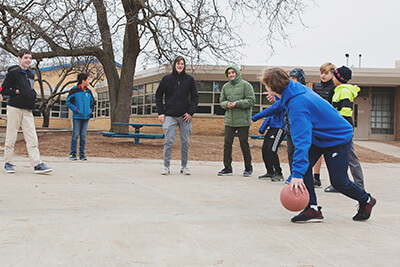January 3, 2019

by Renee Wright, Lower School Director
Editor’s Note: On the first Thursday of each month, you will find a guest blog post here from one of MPA’s division directors. We hope you will enjoy reading their thoughts and reflections about life at MPA.
“It is time to warm up our bodies and brains and get ready for a new week of learning.” These words are spoken every Monday morning at the start of the Lower School Meeting, right before students and teachers participate in the “BrainDance.” Developed by Anne Green Gilbert, an educator and author who founded the Creative Dance Center in Seattle, the BrainDance is a series of exercises and developmental movement patterns that prepare students for learning, promote appropriate behaviors, and develop social skills. This is just one way that MPA teachers promote movement to enhance learning.
What does research tell us about the relationship between movement and the brain? Prior to 1995, researchers believed that the health benefits of exercise were limited to the body. Recent research has shown, however, that regular physical activity and movement benefit more than just the body—they actually augment brain function. Movement supplies brain cells with oxygen, promotes the production of new brain cells, and aids in creating new synapses. In experiments at the University of Illinois, rats that exercised had a greater number of neuron connections than non-exercising rats (Greenough & Anderson, 1991). Movement triggers the release of a brain-derived neurotrophic factor known as BDNF (Kesslak, Patrick, So, Cotman, & Gomez-Pinilla, 1998). This natural substance enhances cognition by boosting a neuron’s ability to communicate with other neurons. Movement also increases energy, reduces stress, and calms the mind and body. Research shows that exercise may stimulate the production of brain chemicals norepinephrine and dopamine, which energize and elevate mood (Chaouloff, 1989). In addition, studies link movement to better memory and reduced likelihood of depression (Kempermann, 2002). Other research studies reveal that exercise improves classroom behavior, academic performance, and social skills (Dwyer, Sallis, Blizzard, Lazarus, & Dean, 2001). As a result of multiple research studies, schools now understand that students learn better, behave better, and are socially more successful when they have physical activity and movement breaks throughout the school day.
Mounds Park Academy is committed to ensuring that students get plenty of movement and physical activity throughout the day. Recess is built into the daily schedule and provides time for unstructured activity, movement, and play. Lower School students enjoy 30 minutes of recess daily, which equates to 150 minutes per week. Middle School students enjoy recess for 25 minutes daily, which equates to 125 minutes per week. Upper School students enjoy 30 minutes of recess or community-building time daily to be active. The American Academy of Pediatrics identifies three overarching benefits of recess that align with the research. They site cognitive and academic benefits, social and emotional skill development, and physical health benefits, such as the reduction of childhood obesity.
Physical Education classes at MPA also provide time for structured physical activity. Lower School students average about 120 minutes of P.E. per week and Middle School students get about 175 minutes per week. Upper School students are required to take 1 credit of P.E. and have the opportunity to take additional P.E. courses if desired. MPA stands out in this area when we learn that approximately 68 percent of high school students nationwide do not participate in P.E. programs (Grunbaum et al., 2002). Additional research has found that students who engage in daily P.E. show not only notable motor fitness, but stronger academic performance and enhanced attitude toward school than students who do not participate in P.E. daily (Donevan & Andrew, 1986). It is very evident that time spent at recess and in P.E. classes keeps students moving and delivers huge health benefits to the body and brain.
Additionally, teachers intentionally integrate movement activities into everyday learning at MPA. Daily stretching, mindfulness breathing and movement activities, walks, drama and music classes, and classroom energizer activities are just a few examples of this integration. These movement breaks occur multiple times throughout the school day and are especially important before tests, presentations, and high stress situations.
Students across all three divisions confirm that movement helps them learn better and is an essential part of their day. They say movement helps them focus on assignments for longer periods of time, gives them something to look forward to, and makes learning more meaningful and joyful. Teachers say that recess and P.E. are essential parts of the curriculum and that movement activities during transition times in the classroom help students focus and engage, and enhance motivation and morale.
Mounds Park Academy is ahead of many schools in its commitment to movement and physical activity. Movement activities are an integral part of the curriculum and are considered as important as “book work.” This is one more way that MPA strives to educate the whole child and prepares students for a lifetime of learning and success.